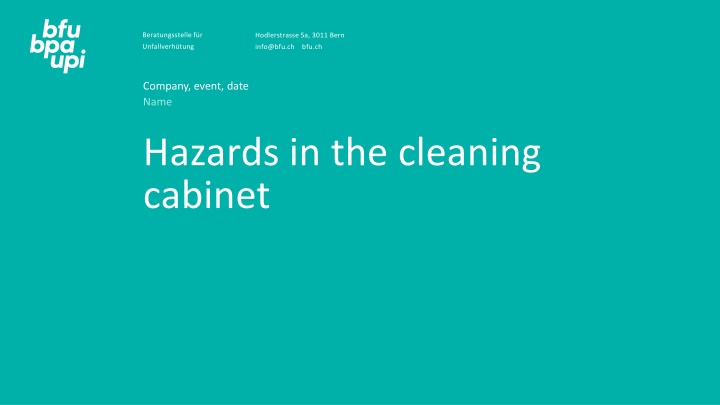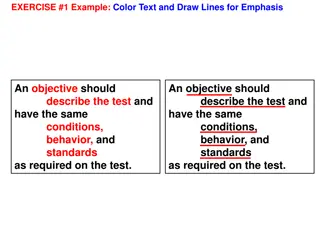
Hazard Symbols and Safety Precautions for Chemical Products
Discover the importance of hazard symbols on chemical products, learn about common hazards around the home, and find out how to handle toxic products safely. Be a conscious consumer, pay attention to safety instructions, and protect yourself from potential dangers. Stay informed to make informed decisions about the products you use.
Download Presentation

Please find below an Image/Link to download the presentation.
The content on the website is provided AS IS for your information and personal use only. It may not be sold, licensed, or shared on other websites without obtaining consent from the author. If you encounter any issues during the download, it is possible that the publisher has removed the file from their server.
You are allowed to download the files provided on this website for personal or commercial use, subject to the condition that they are used lawfully. All files are the property of their respective owners.
The content on the website is provided AS IS for your information and personal use only. It may not be sold, licensed, or shared on other websites without obtaining consent from the author.
E N D
Presentation Transcript
Beratungsstelle fr Hodlerstrasse 5a, 3011 Bern Unfallverh tung info@bfu.ch bfu.ch Company, event, date Name Hazards in the cleaning cabinet
Dishwashing liquid in the kitchen, the garden and solvents in the workroom: there are countless toxic hazards in and around the home. Get to grips with toxins with sound basic knowledge and the necessary precautions. 2
Why do chemical products have hazard labels? Chemical products must be handled responsibly, as chemical substances can pose a wide range of hazards. The symbol on the label provides a first indication of the dangers associated with the product. The safety information provides general instructions on product handling, use, protective measures, disposal and what to do in the event of an accident. cheminfo.ch 3
Be a conscious consumer Pay attention to the hazard symbols and safety instructions when buying and before using a product. Replace toxic products with non-toxic ones. 4
Use safely Pay attention to the hazard symbols. Follow the usage and safety instructions. Wear appropriate protective equipment (protective gloves and/or glasses). Make sure your work area is properly ventilated in case of toxic fumes. Never leave products unattended. 5
Whats on the label? Hazard symbols: draw attention to the hazard. Hazard warnings: provide a detailed description of the hazard. Hazard symbols Hazard warnings Safety information: describes how to handle the product safely. Hazard level: All chemicals classified as hazardous carry the signal word danger or warning . Safety information Hazard level 6
The 9 hazard symbols HEALTH HAZARD May cause skin irritation, trigger allergies or eczema, and cause drowsiness. May trigger poisoning after a single contact. May damage the ozone layer. HIGHLY FLAMMABLE May ignite on contact with flames and sparks, or as a result of impact, friction, heat, contact with air or water! May ignite, even without external influences, if stored incorrectly. OXIDISING May cause or accelerate fires. Releases oxygen when burnt and can only be extinguished with specific agents. It is impossible to smother the flames. 7
The 9 hazard symbols EXPLOSIVE May explode on contact with flames or sparks, or as a result of impact, friction or heat. May cause an explosion, even without external influences, if stored incorrectly. PRESSURISED GAS Contains compressed, liquefied or dissolved gases. Odourless or invisible gases may escape unnoticed. Heat or deformation may cause containers of compressed gas to burst. HAZARDOUS TO THE AQUATIC ENVIRONMENT May cause acute harm to acquatic organisms such as fish, aquatic insects and aquatic plants in low concentrations or over a prolonged period. 8
The 9 hazard symbols CORROSIVE May cause severe skin burns and eye damage. May dissolve certain materials (e.g. textiles). Is dangerous to animals, plants and organic material of all kinds. SERIOUS HEALTH HAZARD May damage certain organs. May lead to immediate or significant, long-term health impairments, cancer, or damage genetic make-up, fertility or development. May be fatal if it enters the respiratory system. HIGHLY TOXIC Even small quantities may lead to severe poisoning and death. 9
Storage and disposal Keep toxic products and medicines out of children s reach. A lockable cabinet mounted at a height of at least 160 cm is suitable for safe storage. Always store poisons, chemicals and medicines in their original packaging under no circumstances transfer them to food or drink containers. Follow the instructions for safe disposal. 10
What to do in an emergency In case of loss of consciousness, respiratory failure or cardiac arrest: call 144 immediately In case of suspected poisoning: call Tox Info Suisse on 145 11
More information Get more information on the topic in the BFU brochure Gifte und Chemikalien Genau geschaut, gut gesch tzt (Art. no. 3.011) It can be ordered free of charge at bfu.ch/bestellen. Find more accident prevention tips at bfu.ch. Further information available from the Federal Office of Public Health FOPH: Chemicals (admin.ch) 13






















